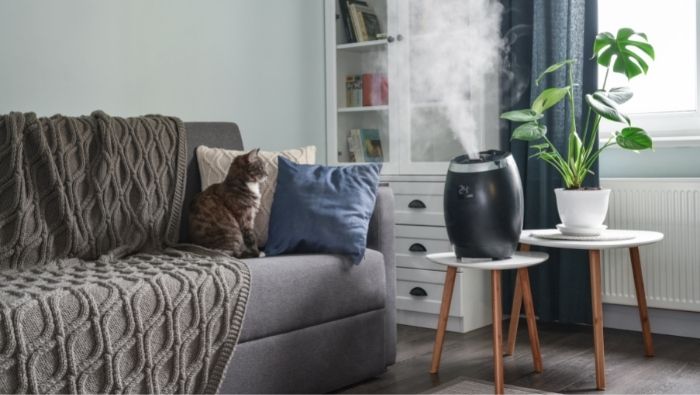Humidifiers & Vaporizers: Inexpensive Investments in Health and Comfort
We explore how vaporizers and humidifiers can be relatively cheap investments in your overall health and comfort during cold weather months.
by Debra Karplus

This article contains affiliate links. The Dollar Stretcher is an Amazon Associate and earns a small commission at no cost to you if you click on a link and make a purchase.
Dehumidifiers are especially helpful, especially during spring, fall and summer, if you are not using central air conditioning in your home to keep moisture levels from getting too high.
So why might you also need a humidifier or vaporizer?
Certain Health Symptoms Might Indicate a Need for a Humidifier
Especially during cold weather months, you may notice that your nose, lips, skin, or other parts feel unusually dry, maybe even itchy. Possibly, your allergies are more annoying than usual, and you are experiencing more colds or respiratory problems. Maybe your mate accuses you of snoring more, or perhaps when you touch something in the house, you get that little electrical spark.
All of these are signs that the humidity in your house may be too low.
Sign Up for Savings
Subscribe to get money-saving content by email that can help you stretch your dollars further.
Twice each week, you'll receive articles and tips that can help you free up and keep more of your hard-earned money, even on the tightest of budgets.
We respect your privacy. Unsubscribe at any time.
Your House and Personal Possessions Can Be Damaged by Low Humidity
Too much dryness in a house can also permanently damage things inside the house, particularly those made of wood, like your treasured furniture, wooden baseboards, and built-in cupboards, cabinets and shelving.
How Do You Know If You Need a Humidifier?
Your first line of defense is to check the humidity levels inside various rooms in your home. That can easily be done using a hygrometer. For $15 or less, you can go to any big box or discount store and buy one or order one from Amazon:
Give the hygrometer some time in various areas inside your home to test humidity levels. Be sure all windows and doors to the outside are closed to get the most accurate reading. If levels are hovering below approximately 30%, then it may be time to start measuring the number of rooms in your home that need the humidity increased and start looking online at dehumidifiers.
A Few Things To Consider When Choosing a Humidifier
What size and type of humidifier should you buy, and how many do you need?
Cool vs. Warm Mist Humidifiers
Your first decision is whether you should purchase a cool mist versus a warm mist humidifier.
According to Sylvane.com, warm mist humidifiers are perfect in small rooms and are more inclined to kill bacteria and mold than cool mist humidifiers. However, there are many important advantages to using a cool mist humidifier. They typically use less electricity, are great in large areas of your home, and don’t have the risk of burns as warm mist humidifiers do, which is an important consideration if there are small children in your family.
Humidifier Features
Look at online consumer ratings to determine features you want, such as ease of use. Also, it’s important to know how noisy the humidifier is, especially if it will be in a bedroom or a part of the house where you entertain guests.
You also want to know if it has a timer or automatic shut-off when humidity reaches the desired level, as well as how often you will need to add water to it. Maintenance varies from model to model, but typically just involves cleaning the tank regularly to reduce the risk of mold. You should expect to pay between $30 and $170, depending on the size and features of the desired humidifier.
Humidifier Sizes
When it comes to humidifier size, you have several options.
There are table-top models for tiny areas. Small ones are great for areas of less than 300 square feet. Medium humidifiers work for areas of 300 to 499 square feet. Large ones are great for 500 to 999-square-foot areas, and extra-large humidifiers are designed for square footage of greater than 1,000. There are also whole-house humidifiers that are tapped into the ducts of your heating system and are best installed by a heating and cooling professional.
| Coverage | Brand |
| Small Space | HoMedics Portable Humidifier |
| 220 sq. ft. | Babymoov Hygro Plus Cool Mist Humidifier 3-in-1 Humidity Control |
| 400 sq. ft. | Honeywell HUL430W Designer Series Cool Mist Humidifier |
| 600 sq. ft. | Lasko UH300 Warm and Cool Humidistat and Timer |
When To Choose a Vaporizer Instead of a Humidifier
Vaporizers are great in small areas and are especially helpful in a bedroom for those with respiratory problems since they typically use an inhalant like eucalyptus. Though they are great for a respirator system, they do nothing to help soothe dry skin.
They require much more maintenance than humidifiers, and because they spew a warm mist into the air, there is a great risk of burns. You should expect to pay between $11 and $90 for a vaporizer.
For under about $200, a humidifier or vaporizer can be a relatively cheap investment in your overall health.
Reviewed September 2024
About the Author
Debra is an occupational therapist, accountant, teacher and freelance writer. Learn more about her at DebraKarplus.blogspot.com.
Popular Articles
On After50Finances.com
- 9 Things You Need to Do Before You Retire
- You Didn’t Save Enough for Retirement and You’re 55+
- When Empty Nesters Reorganize and Declutter Their Home
- Reinventing Your Career in Your 50s or 60s
- What Mature Homeowners Should Know about Reverse Mortgages
- 2 Reasons to Collect Social Security Benefits As Soon As Possible

